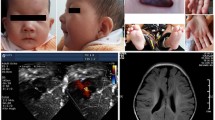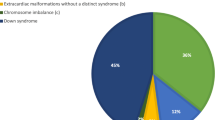Abstract
The association between trisomy 21 and a high incidence of atrioventricular canal defects (AVCDs) indicates that a locus on chromosome 21 is involved in this congenital heart defect. We have investigated whether a genetic locus on chromosome 21 is also involved in familial nonsyndromic AVCDs. Short tandem repeat polymorphisms (STRPs) from chromosome 21 were used for linkage analysis of a family having multiple members affected with AVCDs. In this family, the gene for AVCDs is transmitted as an autosomal dominant with incomplete penetrance. The affected family members are nonsyndromic and have normal karyotypes. Two-point and multipoint linkage analyses produced significantly negative LOD scores for all informative markers. A comparison of the overlapping exclusion distances obtained for each marker at LOD equal -2.0 with the 1000:1 consensus genetic map of the markers, excludes chromosome 21 as the genetic location for AVCDs in this family. The exclusion of chromosome 21 indicates that another gene, not located on chromosome 21, is involved in atrioventricular canal defect formation.
Similar content being viewed by others
References
Antonarakis SE (1992) Meeting report: 3rd International Workshop on Human Chromosome 21. Genomics 14:1126–1132
Cox DR, Smith SA, Epstein LB, Epstein CJ (1984) Mouse trisomy 16 as an animal model of human trisomy 21 (Down syndrome): formation of viable trisomy 16 ↔ diploid mouse chimeras. Dev Biol 101:416–424
Disegni E, Pierpont ME, Bass JL, Kaplinsky E (1985) Two-dimensional echocardiography in detection of endocardial cushion defects in families. Am J Cardiol 55:1649–1652
Epstein CJ, Berger CN, Carlston EJ, Chan PH, Ting-Ting H (1990) Molecular genetics of chromosome 21 and Down syndrome. Wiley-Liss, New York, pp 215–232
Ferencz C, Rubin JD, McCarter RJ, Boughman JA, Wilson PD, Brenner JI, Neill CA, Perry LW, Hepner SI, Downing JW (1987) Cardiac and noncardiac malformations: observations in a population based study. Teratology 35:367–368
Grimberg J, Nawaschiko S, Belluscio L, McKee R, Truck A, Eisenberg A (1989) A simple and efficient non-organic procedure for the isolation of genomic DNA from blood. Nucleic Acids Res 17:390
Haldane JBS (1919) The combination of linkage values and the calculation of distances between the loci of linked factors. J Genet 8:299–309
Korenberg JR, Kawashima H, Pulst S-M, Ikeuchi T, Ogasawara N, Yamamoto K, Schonberg SA, West R, Allen L, Magenis E, Ikawa K, Taniguchi N, Epstein CJ (1990) Molecular definition of a region of chromosome 21 that causes features of the Down syndrome phenotype. Am J Hum Genet 47:236–246
Korenberg JR, Bradley C, Disteche CM (1992) Down syndrome: molecular mapping of the congenital heart disease and duodenal stenosis. Am J Hum Genet 50:293–302
Lathrop GM, Lalouel JM (1984) Easy calculation of LOD scores and genetic risks on small computers. Am J Hum Genet 36:460–465
McCormick MK, Schingel A, Petersen MB, Stetten G, Driscoll DJ, Cantu ES, Tranebjaerg L, Mikkelsen M, Watkins PC, Antonarakis SE (1989) Molecular genetic approach to the characterization of the “Down syndrome region” of chromosome 21. Genomics 5:325–331
MacDonald G, Chu M-L, Cox DR (1991) Fine structure physical mapping of the region of mouse chromosome 10 homologous to human chromosome 21. Genomics 11:317–323
Miyabara S, Gropp A, Winking H (1982). Trisomy 16 in the mouse fetus associated with generalized edema, cardiovascular and urinary tract anomalies. Teratology 25:369–380
O'Nuallain S, Hall JG, Stamm SJ (1977) Autosomal dominant inheritance of endocardical cushion defect. Birth Defects 13:143–147
Nora JJ (1968) Multifactorial inheritance hypothesis for the etiology of congenital heart diseases: the genetic-environmental interaction. Circulation 38:604–611
Rahmani Z, Blouin J-L, Creau-Goldberg N, Watkins P, Mattei J-F, Poissonnier M, Prieur M, Chettouh Z, Nicole A, Aurias A, Sinet P-M, Delabar J-M (1990) Down syndrome critical region around D21S55 on proximal 21q22.3. Am J Med Genet [Suppl] 7:98–103
Scambler PJ, Carey AH, Wyse RKH, Roach S, Dumanski JP, Nordeuskjold M, Williamson R (1991) Microdeletion within 22q11 associated with sporadic and familial Di George syndrome. Genomics 10:201–206
Weber JL, May PE (1989) Abundant class of human polymorphisms which can be typed using polymerase chain reaction. Am J Hum Genet 44:388–396
Yao J, Thompson MW, Trusler GA, Trimble AS (1968) Familial atrial septal defect of the primum type: a report of four cases in one sibship. Can Med Assoc J 98:218–219
Author information
Authors and Affiliations
Rights and permissions
About this article
Cite this article
Cousineau, A.J., Lauer, R.M., Pierpont, M.E. et al. Linkage analysis of autosomal dominant atrio ventricular canal defects: exclusion of chromosome 21. Hum Genet 93, 103–108 (1994). https://doi.org/10.1007/BF00210591
Received:
Issue Date:
DOI: https://doi.org/10.1007/BF00210591




